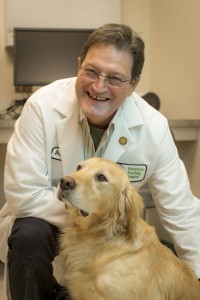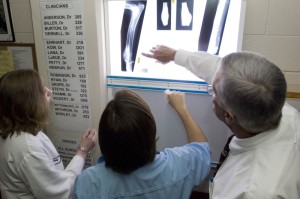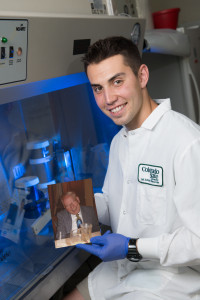Student Jonathan Rosario: ‘How I look at diversity’
Student Affairs in Higher Education masters student Jonathan Rosario is providing general assistance and support in planning Colorado State University's Diversity Symposium, Sept. 16-18.
Student Affairs in Higher Education masters student Jonathan Rosario is providing general assistance and support in planning Colorado State University's Diversity Symposium, Sept. 16-18.
Adam Daurio has been named the director of Administration for the Temple Grandin Equine Center Program.
Deans from the nation's top two veterinary programs both hope to be No. 1 in Saturday's football game – and in generating scholarship donations.
Colorado State University employee Keith Jentzsch, Programs and Exhibitions Coordinator for the University Art Museum, was seriously injured in an assault near his home in Fort Collins on August 7. He faces a long recovery and rehabilitation period. A benefit reading and silent auction to help his family with medical bills has been scheduled for 6 p.m. Friday, Sept. 12, at the Downtown Artery, 252 Linden Street. If you are unable to attend the event, you can contribute to the fund set up for Keith.
Colorado State University and the city of Fort Collins team up every year to knock on doors and welcome new students to town as well as chat with long term residents to promote neighborliness.
Dr. Rodney Page thinks the dog is a cancer patient's best friend.
Not in the way you might think. Yes, dogs offer loyal companionship that might be especially meaningful to a pet owner facing disease diagnosis and treatment.
Yet there’s more. Page, as director of Colorado State University’s world-renowned Flint Animal Cancer Center, is leading a push within the field of cancer medicine to view dogs with naturally occurring disease as the ideal route to improving cancer treatment in people.
On Thursday, the Stephen J. Withrow Presidential Chair in Oncology will be officially conferred to Page during a reception on campus, a ceremony significant for what the chair will provide: funding to support studies that promise to help both pets and people with cancer.
An academic chair is a funding mechanism that provides investment revenue from an endowment – in this case, an impressive $6 million endowment – to boost teaching, research and service in a field of interest to donors. This chair is named for Dr. Steve Withrow, founding director of the CSU Animal Cancer Center, University Distinguished Professor and pioneer in the field of veterinary oncology.
Funding from the prestigious chair will allow Page to carry on Withrow’s legacy in treating pets with cancer and applying the knowledge gained to improve treatment for people with cancer.
What does that mean?
It starts here: The Animal Cancer Center books some 6,000 appointments each year with animal cancer patients, primarily dogs. Job No. 1 is healing these patients with medication, surgery, radiation and chemotherapy.
As Page often says, “Cancer is cancer,” meaning the disease appears, progresses and responds to treatment in much the same way no matter the species. So it makes sense that human treatment should benefit from the vast medical data and knowledge gained in the course of treating pets.
Withrow was an early proponent. When Page took over as center director in 2010, he likewise took up the mantle of canine oncology within the sphere of translational medicine, meaning medical knowledge that may be translated from one species to another.
One-on-one with Page [caption id="attachment_12101" align="alignright" width="200"] Dr. Rod Page, director of the Flint Animal Cancer Center.[/caption]
Dr. Rod Page, director of the Flint Animal Cancer Center.[/caption]
Page, a CSU veterinary alumnus who was mentored by Withrow, explains the translational role of canine oncology – and more – in the following Q&A.
What does it mean to you to have more than 700 people contribute to this chair you’re holding?That’s pretty phenomenal, isn’t it? The chair is an honor to Steve, and that’s the most significant part of this. The relationship Steve has had with hundreds of thousands of students, residents, clients, people who call from all over the world for his opinion on their cases, really is unique. I don’t think I’ve known anyone else who has devoted that level of commitment to this profession. It shows in the core values that Steve established for our cancer center, of vision, integrity and passion. Hundreds of donors have joined in support of those values.
In what ways are you carrying on Dr. Withrow’s legacy?I hope I can continue to foster compassion for clients and their pets, and I hope I can emulate Steve’s focus and understanding about what’s important. Since I returned to CSU, I’ve learned a lot more about the spirit of the Animal Cancer Center, the teamwork and the focus. People here support each other, and that creates a feeling of shared respect. That’s something that has to continue.
Dr. Withrow saw the canine oncology patient very early in his career as a model for understanding human cancer. That has continued at the Flint Animal Cancer Center, and is part of the legacy you carry on. Yet, it’s still a concept not a lot of people know about. Can you explain?Cancer is cancer. The same mechanisms that result in cancer in humans are operative in dogs, and are operative in other animals as well. The thing that is valuable – and I believe will continue to grow in its value – is the information that can be gathered through well-done clinical studies in companion animals with naturally occurring cancers. The ability to look at why a tumor spreads or why a tumor becomes resistant to drugs in a relevant environment is how we foresee our scientific program growing in the future.
What’s your elevator speech if you were to meet an oncologist in human medicine and they hadn’t been exposed to the concept of using dogs with cancer as a model for understanding human cancer?It starts with noting that dogs share our environment. They’re exposed to the same sorts of insults that we are exposed to, and they develop naturally occurring, genetically based diseases more than any other species next to man. More than 400 diseases have been identified as genetically based, and many of those are cancer. In addition, dogs age much more rapidly than people, so tumors develop much more rapidly. This means that, as we treat our canine patients, we can ask and answer the same questions but in a fraction of the time that it takes in a human study.
Talk a little bit about the comparative oncology trials that are ongoing at the Flint Animal Cancer Center. How would you summarize the overall goal of those trials?Whether the study is about improving animal health, or whether it is a lead-in to a human trial, the focus is always on innovation – trying to find ways to do it better, trying to overcome limitations on treatment for cancers. It’s all about improving the bottom line of cancer treatment. We have trials that are conducted for cancer drugs, radiation, new diagnostic tests, and all are part of moving the profession forward for the benefit of pets and people.
Could you point to three major breakthroughs at the Flint Animal Cancer Center that have had a direct influence on human cancer treatment and its effectiveness? [caption id="attachment_12102" align="alignright" width="300"] Dr. Steve Withrow, studies a patient’s radiographs with colleagues.[/caption]
Dr. Steve Withrow, studies a patient’s radiographs with colleagues.[/caption]
The home runs that have been provided already include an understanding of radiation response for head and neck cancer, which was done by Dr. Ed Gillette in the ’90s. Up until the advent of very new technologies, that was the basis for the treatment protocol. There’s also the limb-sparing surgery for cancer patients that was advanced by Steve and Dr. Ross Wilkins, a human orthopedic surgeon. It has allowed patients, primarily children, to keep their limbs when undergoing cancer surgery and is recognized as the standard for kids with bone cancer. Another example is the development of a product that stimulates the immune system and has resulted in an improvement in survival for kids with bone cancer by delaying metastasis. That product is currently available, but not yet in the United States because of regulatory issues.
Of some of the studies you currently have under way, is there something that shows particular promise for advancing human cancer treatment and its understanding?We’re involved with a study, funded by the National Cancer Institute, which involves multiple institutions and is evaluating compounds for the treatment of lymphoma, a cancer that affects the immune system. We are looking at the response to treatment in dogs with lymphoma, and we’re also looking at how well this product will work at the microscopic level.
I also have to ask you: Are you a dog lover? If so, how has that influenced your work as a veterinary oncologist?I am a dog lover – and a cat lover, and a bird lover, and a wildlife lover. I started out as a bioscience major in college and was uncertain of the next step so I enrolled in a program at a medical school. I wanted to find out what it was like in medical school, and with that experience I decided I wanted to be a veterinarian because of my love for animals. I’ve also had wonderful veterinary mentors my entire career, and that helped me tremendously.
Flint Animal Cancer Center The disease that ended his grandfather's life has shaped student Lukas Foster's in a different way.
Parkinson’s disease hits close to home for Foster, a Colorado State University biomedical sciences major whose grandfather, Willie Bandorf, suffered from the progressive neurological disorder. So he was the one person Foster wished he could tell when he earned a Best in Show award at CSU’s 2014 student research competition for his study of Parkinson’s.
“His eyes would light up whenever I talked about my research,” said Foster, whose project is supported with funding from the Michael J. Fox Foundation for Parkinson’s Research.
“He loved that I was learning about Parkinson’s disease and working towards a positive change for others affected by it,” said Foster, a senior in theCollege of Veterinary Medicine and Biomedical Sciences. “He told me to always think of him.”
Parkinson’s disease – affecting an estimated 1 million people in the United States – cannot be cured. Rather, treatments aim to control tremors and other movement impairments that characterize the disease; physical therapy, medication and deep brain stimulation are among the therapies used, even as scientists explore stem-cell therapy and other novel possibilities.
Quest for improved treatment
Foster’s winning project, “A novel diindolylmethane analog, DIM-C-pPhBr, suppresses neuroinflammatory gene expression in BV-2 microglia cells,” represents the quest for improved treatment: It examines compounds that hold potential for quelling neuroinflammation, which has been found to have a role in progression of Parkinson’s disease.
Foster displayed his research findings at the 2014 CSU Celebrate Undergraduate Research and Creativity showcase. He was one of just three students to earn the Best in Show honor among more than 200 total participants whose research posters were judged.
“With this research, we could find a way to delay symptoms of Parkinson’s disease to the point where people may have it at the time of their death, but it won’t have a great impact on them,” Foster said, reflecting on his grandfather’s dramatically impeded speech and mobility.
Foster has worked in the laboratory of Ronald Tjalkens, a professor of toxicology and neuroscience whose research into Parkinson’s disease is supported by the Michael J. Fox Foundation and National Institutes of Health.
Tjalkens said he recently presented data from his lab’s research to the Michael J. Fox Foundation in New York.
“It was extremely well received because of the clear implications for improving therapy for Parkinson’s patients,” Tjalkens said. “I have every confidence that Lukas will continue to be a valuable team member on this important project.
“It is uncommon for an undergraduate student to be performing at this level so early in their college career, but he has been a tremendous contributor to the success of this project,” Tjalkens added.
Extensive research possibilities
Foster, who plans to attend medical school, applied to work in the Tjalkens laboratory as a freshman. His passion for understanding Parkinson’s disease made it a natural fit.
“I find it most interesting that nobody knows what causes Parkinson’s diseases or how to cure it,” Foster said. “The research possibilities are endless. It’s an open book for new discoveries being made and real solutions developing.”
When he began his research, Foster eagerly shared his experiences with his grandfather, who died in January 2013. Bandorf could not speak, but showed his support with thumbs-up gestures.
“I knew I was making him proud,” Foster said, smiling. “I understand more and more how this disease affected his life. I’m putting the pieces together to understand the pathway of neurodegeneration and thinking of him every step of the way.”
The disease that ended his grandfather's life has shaped student Lukas Foster's in a different way.
Parkinson’s disease hits close to home for Foster, a Colorado State University biomedical sciences major whose grandfather, Willie Bandorf, suffered from the progressive neurological disorder. So he was the one person Foster wished he could tell when he earned a Best in Show award at CSU’s 2014 student research competition for his study of Parkinson’s.
“His eyes would light up whenever I talked about my research,” said Foster, whose project is supported with funding from the Michael J. Fox Foundation for Parkinson’s Research.
“He loved that I was learning about Parkinson’s disease and working towards a positive change for others affected by it,” said Foster, a senior in theCollege of Veterinary Medicine and Biomedical Sciences. “He told me to always think of him.”
Parkinson’s disease – affecting an estimated 1 million people in the United States – cannot be cured. Rather, treatments aim to control tremors and other movement impairments that characterize the disease; physical therapy, medication and deep brain stimulation are among the therapies used, even as scientists explore stem-cell therapy and other novel possibilities.
Quest for improved treatment
Foster’s winning project, “A novel diindolylmethane analog, DIM-C-pPhBr, suppresses neuroinflammatory gene expression in BV-2 microglia cells,” represents the quest for improved treatment: It examines compounds that hold potential for quelling neuroinflammation, which has been found to have a role in progression of Parkinson’s disease.
Foster displayed his research findings at the 2014 CSU Celebrate Undergraduate Research and Creativity showcase. He was one of just three students to earn the Best in Show honor among more than 200 total participants whose research posters were judged.
“With this research, we could find a way to delay symptoms of Parkinson’s disease to the point where people may have it at the time of their death, but it won’t have a great impact on them,” Foster said, reflecting on his grandfather’s dramatically impeded speech and mobility.
Foster has worked in the laboratory of Ronald Tjalkens, a professor of toxicology and neuroscience whose research into Parkinson’s disease is supported by the Michael J. Fox Foundation and National Institutes of Health.
Tjalkens said he recently presented data from his lab’s research to the Michael J. Fox Foundation in New York.
“It was extremely well received because of the clear implications for improving therapy for Parkinson’s patients,” Tjalkens said. “I have every confidence that Lukas will continue to be a valuable team member on this important project.
“It is uncommon for an undergraduate student to be performing at this level so early in their college career, but he has been a tremendous contributor to the success of this project,” Tjalkens added.
Extensive research possibilities
Foster, who plans to attend medical school, applied to work in the Tjalkens laboratory as a freshman. His passion for understanding Parkinson’s disease made it a natural fit.
“I find it most interesting that nobody knows what causes Parkinson’s diseases or how to cure it,” Foster said. “The research possibilities are endless. It’s an open book for new discoveries being made and real solutions developing.”
When he began his research, Foster eagerly shared his experiences with his grandfather, who died in January 2013. Bandorf could not speak, but showed his support with thumbs-up gestures.
“I knew I was making him proud,” Foster said, smiling. “I understand more and more how this disease affected his life. I’m putting the pieces together to understand the pathway of neurodegeneration and thinking of him every step of the way.”
More than 2,500 Poudre School District students will begin their school year with wide smiles and new supplies thanks to School is Cool.
School is Cool, started at CSU 23 years ago, provided backpacks and grade-specific supplies to 2,511 students. More than 110 volunteers spent four days organizing materials, stuffing backpacks and delivering them to PSD schools.
This year 42 PSD schools will receive backpacks, including every middle school and high school. The program has distributed nearly 35,000 backpacks since it was launched by CSU employees in 1992.
Corporate, campus supportThe School is Cool committee has partnered with the CSU Bookstore, the Bohemian Foundation, Hewlett-Packard and other organizations to expand its reach. Still, the majority of funding over the past 23 years has come from CSU employees.
Committed to community“We are lucky and proud to call Fort Collins our home, and as a university committed to providing access to education,  School is Cool is an amazing opportunity for CSU to help children in our community get the tools they need to succeed,” said Tom Milligan, CSU’s vice president for external relations. “The CSU community truly believes in education, and through this wonderful program, our staff, faculty and students get to demonstrate that belief in a way that makes a real difference in the lives of school children in our hometown. We are very proud of this great program and thank the hundreds of individuals and the sponsors who make it possible.”
School is Cool is an amazing opportunity for CSU to help children in our community get the tools they need to succeed,” said Tom Milligan, CSU’s vice president for external relations. “The CSU community truly believes in education, and through this wonderful program, our staff, faculty and students get to demonstrate that belief in a way that makes a real difference in the lives of school children in our hometown. We are very proud of this great program and thank the hundreds of individuals and the sponsors who make it possible.”
To support School is Cool, send your gift to: School is Cool, Colorado State University Foundation, 9100 Campus Delivery or donate online.
CSU faculty and staff can take advantage of several upcoming training opportunities offered through Training and Organizational Development. Available classes
8/14 - The Balancing Act
This course is designed to help supervisors balance their own needs for professional accomplishment and effective time management, as well as being a mentor to student and seasonal employees.
Topics include:
9/19 - Caring for a Loved One: Be Prepared
Caring for a loved one can be stressful. This workshop will provide practical information and relevant reference material.
Participants will:
Pre-registration is required. Go to the Training website for registration instructions. Select the “Register for Workshops” button to see class descriptions, and log-in to register.
Contact: Ellen AudleyDoreen E. Jordan, 77, joined her Lord and Savior on Nov. 1.